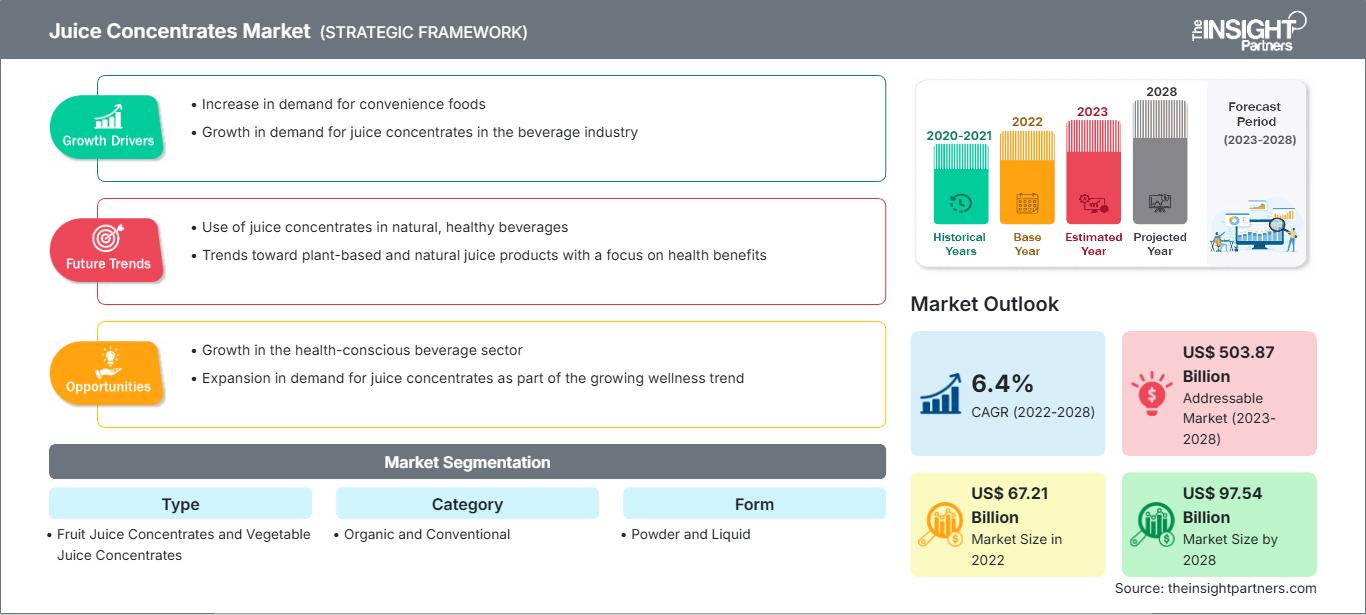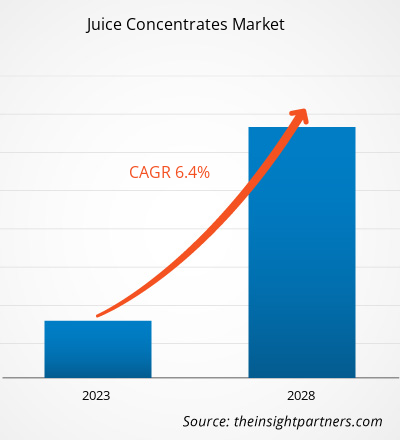The juice concentrates market size is expected to grow from US$ 67,210.96 million in 2022 to US$ 97,541.12 million by 2028; it is estimated to register a CAGR of 6.4% from 2022 to 2028.
Juice concentrates are made by extracting water from fruit and vegetable juices. Depending on the type of fruits and vegetables used during the process, these concentrates offer essential nutrients such as minerals and vitamins. The juice concentrates are highly processed in comparison to the raw juices. The water is extracted in juice concentrates as it helps in reducing bacterial growth. The juice concentrates are generally stored at room temperature or frozen and then diluted in filtered water before consumption. The fruit concentrates are rich in vitamin C and other antioxidants that help promote skin health and slow down the effects of skin aging. It is usually consumed by consumers as a healthy alternative to freshly squeezed juice.
In 2022, Europe held the largest share of the juice concentrates market. The market in Asia Pacific is estimated to grow at the highest CAGR during the forecast period. The market growth in Europe is attributed to the presence of well-established players such as AGRANA Beteiligungs-AG, Archer Daniels Midland Company, Berrifine A/S, Ingredion Incorporated, and Dohler GmbH. With increasing health consciousness among consumers, the demand for natural products prepared using juice concentrates is expected to continue growing over the forecast period. Further, the demand for on-the-go fruit-based beverages is increasing due to hectic lifestyles of consumers across the region. The rising consumption of juice concentrates and juice concentrates products such as soups & sauces and beverages is due to the growing adoption of fruit and vegetable juices over aerated drinks, especially by health-conscious consumers.
Customize This Report To Suit Your Requirement
You will get customization on any report - free of charge - including parts of this report, or country-level analysis, Excel Data pack, as well as avail great offers and discounts for start-ups & universities
Juice Concentrates Market: Strategic Insights

- Get Top Key Market Trends of this report.This FREE sample will include data analysis, ranging from market trends to estimates and forecasts.
You will get customization on any report - free of charge - including parts of this report, or country-level analysis, Excel Data pack, as well as avail great offers and discounts for start-ups & universities
Juice Concentrates Market: Strategic Insights

- Get Top Key Market Trends of this report.This FREE sample will include data analysis, ranging from market trends to estimates and forecasts.
Impact of COVID-19 Pandemic on Juice Concentrates Market
The COVID-19 pandemic affected economies and industries in various countries. Lockdowns, travel restrictions, and business shutdowns in North America, Europe, Asia Pacific (APAC), South & Central America, and the Middle East & Africa (MEA) hampered the growth of several industries, including the food & beverages industry. The shutdown of manufacturing units disrupted global supply chains, manufacturing activities, delivery schedules, and essential and nonessential product sales. Various companies witnessed delays in product deliveries and a slump in sales of their products in 2020. Moreover, the bans imposed by governments of various countries in Europe, Asia Pacific, and North America on international travel compelled companies to temporarily discontinue their collaboration and partnership plans. All these factors hampered various industries in 2020 and early 2021, thereby restraining the growth of various markets, including the juice concentrates market.
Before the onset of the COVID-19 pandemic, the demand for juice concentrates was high due to increasing need for bakery products and rising production of different flavored products. However, manufacturing industries faced unprecedented challenges after the emergence of the pandemic in 2020. The manufacturers of juice concentrate experienced many issues due to supply chain constraints caused by nationwide lockdown, trade bans, and travel restrictions. The supply chain disruption created the storage of raw materials, which affected the production and distribution of juice concentrates, leading to increased prices. Further, there was a huge demand and supply gap due to the lockdown and travel restrictions.
Market Insights
Strategic Developments by Key Players to Favor Juice Concentrates Market Growth During Forecast Period
In May 2022, Austria Juice GmbH, a joint venture between AGRANA Beteiligungs-AG (AGRANA) and Raiffeisen Ware Austria AG (RWA), constructed a large-scale photovoltaic installation on the site of its fruit juice concentrate plant in Kröllendorf, Upper Austria. At this site, the company produces fruit juice concentrates, fruit purées, and natural flavors, as well as beverage compounds and not-from-concentrate juices for the downstream beverages sector. Such strategic developments by key players in the market are expected to propel the growth of the juice concentrates market in the coming years.
Type-Based Insights
Based on type, the juice concentrates market is bifurcated into fruit juice concentrates and vegetable juice concentrates. The fruit juice concentrates segment held a larger market share in 2022, and the vegetable juice concentrates segment is expected to register a higher CAGR during the forecast period. Juice concentrate is made from the extraction of water from fruit juice, and it offers a few essential nutrients, including vitamins and minerals. Removing the water content through evaporation can turn fresh juice into a juice concentrate, which is used as a flavoring agent in other food and beverage products. Fruit concentrates are often mixed with water to recreate delicious, refreshing juice drinks. Fruit juice concentrates are majorly used for making fruit juices, soft drinks, and nectars.
Category Insights
Based on category, the juice concentrates market is bifurcated into organic and conventional. The conventional segment held a larger market share in 2022, and the organic segment is expected to register a higher CAGR during the forecast period. Conventional farming of fruits and vegetables allows the use of synthetic fertilizer, manure, compost, sewage sludge, and other soil amendments. Fruits and vegetables of the conventional category are sprayed with several chemical fertilizers, pesticides, and weedicides, and follow artificial methods such as genetically modified organism techniques. As a result, conventional farming is cheaper than organic farming. Hence, conventional juice concentrates are cheaper than organic ones.
Form-Based Insights
Based on form, the juice concentrates market is bifurcated into powder and liquid. The liquid segment held a larger market share in 2022, and the powder segment is expected to register a higher CAGR during the forecast period. Solvents from the fruits and vegetables and the procured plant extract are available in liquid form. This liquid extract can be further processed to a powder form or distributed in the end-use industries for various applications. The liquid form is the majorly available form of juice concentrate as it requires minimal processing compared to other forms.
Application Insights
Based on application, the juice concentrates market is segmented into bakery and confectionery; beverages; soups, sauces, and condiments; dairy and frozen dessert; and others. The beverages segment held the largest market share in 2022, and the bakery and confectionery segment is expected to register the highest CAGR during the forecast period. Juice concentrates are widely applicable in making organic and conventional beverages such as water plus, fruit splashes, carbonated soft drinks, tea beverages, beer mixes, cider, and spirits, which is boosting the growth of the beverage segment. This growth is also supported by the rising demand for immunity-boosting, healthy, and functional beverages. A few major beverage manufacturers such as Döhler have been providing several products, including CO2-stable concentrates, clarified juice concentrates, and alcohol-stable juice concentrates.
Ciatti Co, Berrifine AS, Archer-Daniels-Midland Co, AGRANA Beteiligungs AG, Dohler GmbH, Kanegrade Ltd, CitroGlobe SRL, SVZ International BV, and IPRONA SpA are among the major players operating in the juice concentrates market. These companies mainly focus on product innovation to expand their market size and follow emerging trends.
Juice Concentrates Market Regional Insights
The regional trends and factors influencing the Juice Concentrates Market throughout the forecast period have been thoroughly explained by the analysts at The Insight Partners. This section also discusses Juice Concentrates Market segments and geography across North America, Europe, Asia Pacific, Middle East and Africa, and South and Central America.
Juice Concentrates Market Report Scope
| Report Attribute | Details |
|---|---|
| Market size in 2022 | US$ 67.21 Billion |
| Market Size by 2028 | US$ 97.54 Billion |
| Global CAGR (2022 - 2028) | 6.4% |
| Historical Data | 2020-2021 |
| Forecast period | 2023-2028 |
| Segments Covered |
By Type
|
| Regions and Countries Covered | North America
|
| Market leaders and key company profiles |
|
Juice Concentrates Market Players Density: Understanding Its Impact on Business Dynamics
The Juice Concentrates Market is growing rapidly, driven by increasing end-user demand due to factors such as evolving consumer preferences, technological advancements, and greater awareness of the product's benefits. As demand rises, businesses are expanding their offerings, innovating to meet consumer needs, and capitalizing on emerging trends, which further fuels market growth.

- Get the Juice Concentrates Market top key players overview
Report Spotlights
- Progressive industry trends in the juice concentrates market to help companies develop effective long-term strategies
- Business growth strategies adopted by market players in developed and developing countries
- Quantitative analysis of the market from 2022 to 2028
- Estimation of global demand for juice concentrates
- Porter’s Five Forces analysis to illustrate the efficacy of buyers and suppliers in the juice concentrates market
- Recent developments to understand the competitive market scenario
- Market trends and outlook, and growth drivers and restraints in the juice concentrates market
- Assistance in the decision-making process by highlighting market strategies that underpin commercial interest
- Size of the juice concentrates market at various nodes
- Detailed overview and segmentation of the market and growth dynamics of the juice concentrates industry
- Size of the juice concentrates market in various regions with promising growth opportunities
Frequently Asked Questions
What are the key drivers for the growth of the global juice concentrates market?
Based on the application, which segment is projected to grow at the fastest CAGR over the forecast period?
Based on the type, why does the fruit concentrates segment have the largest revenue share?
What is the largest region of the global juice concentrates market?
Can you list some of the major players operating in the global juice concentrates market?
What are the opportunities for juice concentrates in the global market?
- Historical Analysis (2 Years), Base Year, Forecast (7 Years) with CAGR
- PEST and SWOT Analysis
- Market Size Value / Volume - Global, Regional, Country
- Industry and Competitive Landscape
- Excel Dataset
Recent Reports
Testimonials
Reason to Buy
- Informed Decision-Making
- Understanding Market Dynamics
- Competitive Analysis
- Identifying Emerging Markets
- Customer Insights
- Market Forecasts
- Risk Mitigation
- Boosting Operational Efficiency
- Strategic Planning
- Investment Justification
- Tracking Industry Innovations
- Aligning with Regulatory Trends





















 Get Free Sample For
Get Free Sample For